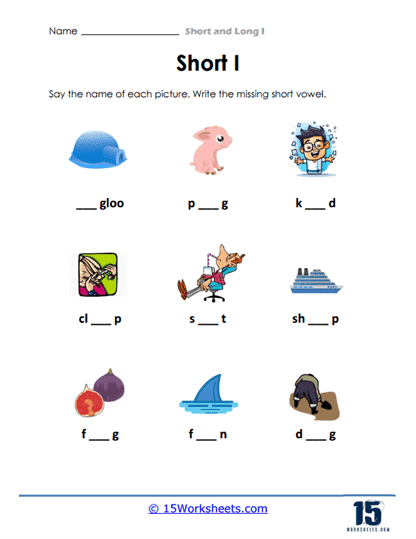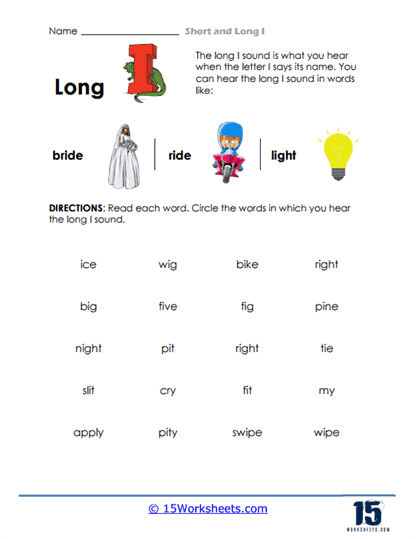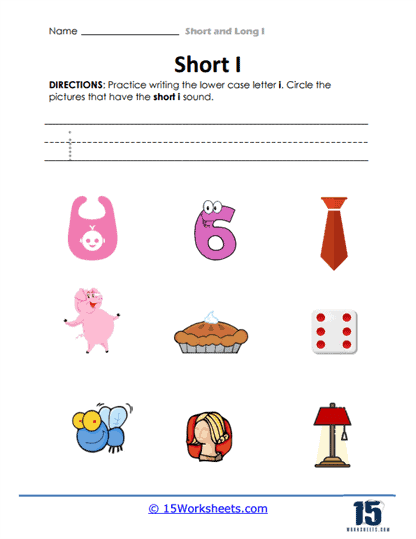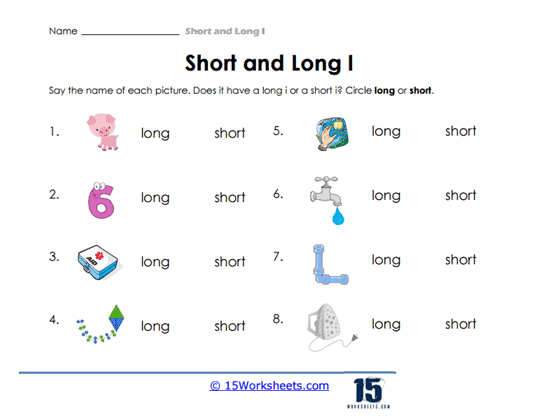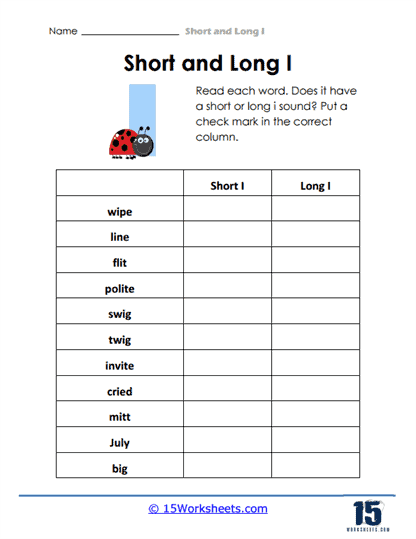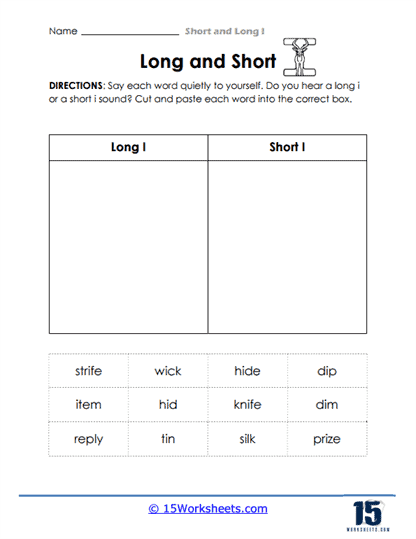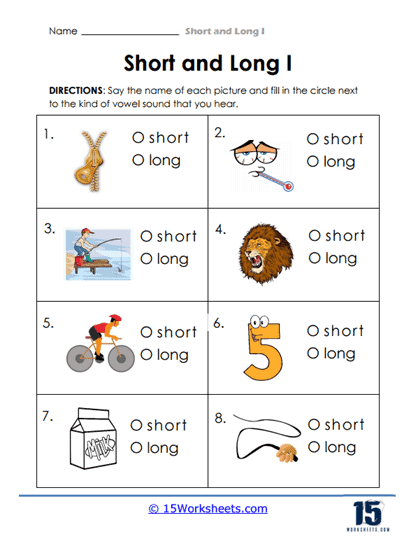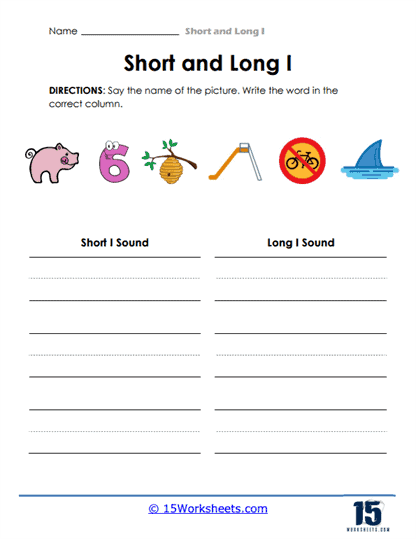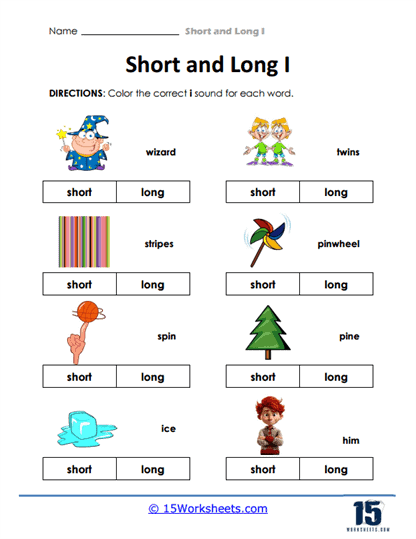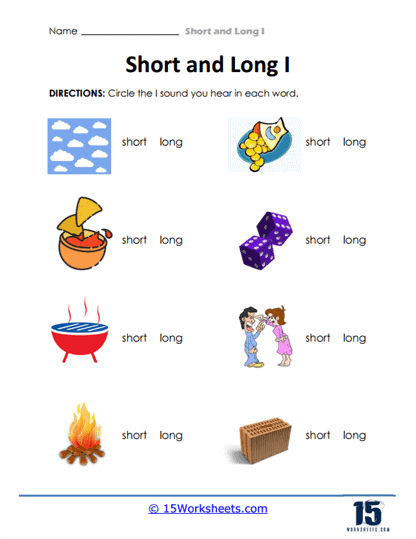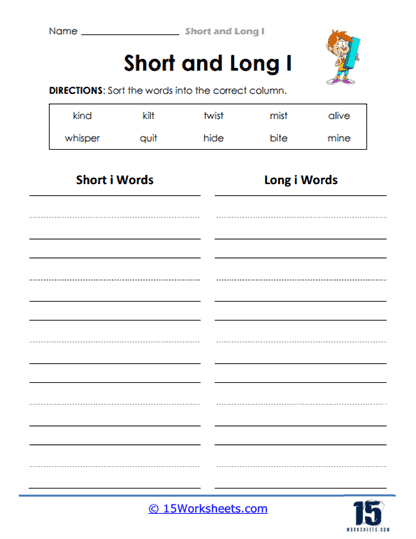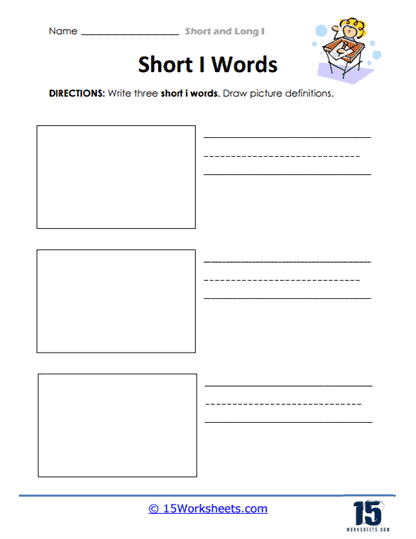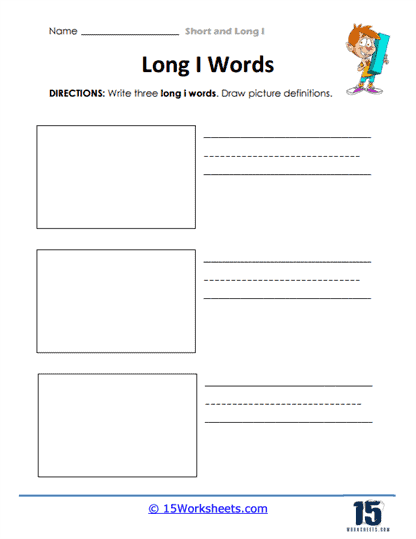Short and Long I Worksheets
All About These 15 Worksheets
Understanding the distinction between short and long vowel sounds, especially the nuances of the ‘I’ sound, is one of the most foundational skills in early literacy and phonics education. For young learners, mastering this concept can significantly impact their ability to read fluently, spell accurately, and develop a strong sense of phonemic awareness. Without a firm grasp of these sounds, children may struggle to decode words, making reading a frustrating experience rather than a joyful discovery. On the other hand, when students confidently differentiate between short and long vowel sounds, they unlock the door to a more fluid, intuitive engagement with language.
Phonemic awareness, or the ability to hear and manipulate individual sounds in spoken words, is the cornerstone of reading success. When children can distinguish between the short ‘I’ in words like “sit” or “pin” and the long ‘I’ in words like “site” or “pine,” they gain a powerful tool for decoding. This skill not only helps in reading but also improves spelling and pronunciation, as students begin to understand the relationship between letters and sounds in a more nuanced way.
To support young learners in developing this critical skill, we’ve carefully crafted a comprehensive set of Short and Long ‘I’ worksheets. These resources are more than just practice sheets—they’re designed to engage students in active learning, encouraging them to explore the differences between short and long ‘I’ sounds in a variety of contexts. Each worksheet is thoughtfully structured to provide both guided and independent practice, helping students to internalize the rules and patterns that govern vowel sounds.
At the heart of these worksheets is the goal to make phonics both accessible and enjoyable. Phonics, often perceived as repetitive or tedious, can be transformed into an exciting adventure with the right tools. The Short and Long ‘I’ worksheets are designed to capture students’ attention with interactive tasks, word games, and visual aids that stimulate critical thinking and auditory discrimination. For example, students may be asked to match pictures with words, identify the correct sound in a list of words, or even create their own sentences using a mix of short and long ‘I’ sounds. These varied activities allow children to encounter the ‘I’ sound in multiple contexts, reinforcing their learning in a dynamic way.
Beyond just learning the rules, these worksheets aim to deepen students’ understanding of language as a whole. As children practice identifying and using short and long ‘I’ sounds, they also begin to develop a more comprehensive awareness of language patterns. This awareness extends beyond just phonics-it fosters a growing appreciation of how language works, how words are constructed, and how meaning is communicated through sound.
In today’s world, where strong literacy skills are more important than ever, early phonics instruction plays a vital role in setting children up for success. The ability to read opens the door to a lifetime of learning, and it all begins with mastering the basics. Short and Long ‘I’ sounds may seem like a small part of the larger puzzle, but they are essential building blocks in a child’s educational journey. When children can confidently navigate these sounds, they are not only becoming better readers-they are becoming empowered learners.
What Are Short And Long I Sounds?
These are magic sheets full of intriguing activities that help you understand the different sounds the letter ‘I’ can make. It’s like having two sounds hiding under the same look!
So, the first sound ‘I’ can make is the short sound. It sounds like ‘i’ in “pin” or “kit”. It’s like saying ‘ih’. Can you try that? Awesome!
The second sound ‘I’ can make is its long sound. This sounds just like the letter ‘I’ itself, like in the words “bike” or “kite”. Can you say ‘eye’? Great work!
The aim of these Short and Long I Vowel worksheets is to help you hear, recognize, and write these sounds correctly. They’re like your treasure maps, guiding you to mastering the sounds of ‘I’. Here’s what you can expect to see on these worksheets:
Word Lists – These lists contain words with either short ‘I’ or long ‘I’ sounds. By reading them, you get familiar with how each sound looks in different words. This exercise will also improve your reading skills.
Matching Games – You will see words and pictures that you have to match correctly. This can be very fun! It’s like solving a puzzle, and it helps you associate the sounds of ‘I’ with familiar objects or actions.
Fill in the Blanks – You will get sentences with words missing, and you have to fill in the correct words with short ‘I’ or long ‘I’ sounds. This helps you understand how the words are used in real sentences.
Coloring Pages – These involve coloring pictures based on the sounds in their names. You might have to color pictures named with short ‘I’ sounds one color, and ones with long ‘I’ sounds another color. This is a fun way to practice recognizing the sounds.
Cut and Paste – In these activities, you will cut out words or pictures and paste them under the correct heading – short ‘I’ or long ‘I’. This can be quite enjoyable and will help reinforce what you’ve learned.
Word Search Puzzles – This is just like being a detective! You find words with short ‘I’ and long ‘I’ sounds hidden in a grid of letters.
Sound Sorting – In this task, you sort words based on whether they contain the short ‘I’ or long ‘I’ sound. This helps strengthen your ability to recognize the different sounds.
Writing Practice – You get to write words with the short ‘I’ and long ‘I’ sounds. Writing helps you remember the sounds better and improves your spelling skills.
Remember, the secret trick is to say the words out loud as you work through the tasks. This helps your ears get familiar with the sounds. And don’t worry if it’s a bit tricky at first. Just like learning to ride a bike or mastering a video game, it gets easier with practice!
Parents, these worksheets are designed to make learning interactive and enjoyable. Your role is to guide and support your child through this journey. Remember, the goal is not just to complete the worksheet but to understand the sounds and recognize them when reading or listening to words. Encourage them, be patient, and make the activities fun. Celebrate their progress, no matter how small. After all, learning is a step-by-step adventure!
Examples of the Long I Sound
“Time” – In the word “time”, the ‘I’ makes the long vowel sound. This means it says its own name, ‘I’, sounding like ‘eye’. The reason for this is the “silent ‘E'” rule in English. When a word has a vowel followed by a consonant and then an ‘E’ at the end, the first vowel often says its name. So, in “time”, the ‘I’ is followed by ‘m’ (a consonant) and then ‘E’ (silent ‘E’), causing ‘I’ to make its long vowel sound.
“Bike” – Similar to “time”, the word “bike” also follows the “silent ‘E'” rule, where the ‘I’ is followed by ‘k’ (a consonant) and then an ‘E’. The ‘E’ is silent and its purpose is to make the ‘I’ say its name, giving us the long ‘I’ sound.
In both “time” and “bike”, the ‘I’ has a long vowel sound because of the “silent ‘E'” rule. This rule is not always the case in English words, but it’s common enough to be a useful guideline when learning to read and spell.
Examples of the Short I Sound
“Sit” – In the word “sit”, the ‘I’ makes the short vowel sound, pronounced as ‘i’ in “pin” or “it”. This sound is often represented as ‘ĭ’. This is a common pattern in English words where a vowel appears between two consonants in a word, in this case ‘s’ and ‘t’. This is called the “closed syllable” pattern, and in such cases, the vowel typically makes its short sound.
“Flip” – Similarly in “flip”, the ‘I’ is placed between two consonants, ‘fl’ and ‘p’. According to the “closed syllable” pattern, the ‘I’ makes the short vowel sound.
In both “sit” and “flip”, the vowel ‘I’ has a short vowel sound because it is located between two consonants. This is a very common pattern in English and can be a helpful rule for learning to read and spell. Remember, while this rule often applies, English is a complex language with many exceptions. That’s what makes it an exciting language to learn!
The Importance of Short and Long I
Understanding the difference between short and long vowel sounds, especially the ‘I’ sound, is of paramount importance for several reasons:
- Reading Proficiency: Accurate recognition of short and long ‘I’ vowel sounds is essential for fluent reading. It enables students to decode words correctly and comprehend text effectively.
- Spelling Competence: Proficiency in distinguishing short and long ‘I’ vowel sounds enhances students’ spelling skills. When they can differentiate between these sounds, they are better equipped to spell words accurately.
- Phonemic Awareness: Recognizing short and long ‘I’ vowel sounds fosters phonemic awareness—the ability to identify and manipulate individual phonemes (sounds). This skill is critical for literacy development and reading comprehension.
- Vocabulary Growth: Learning the nuances of short and long ‘I’ vowel sounds exposes students to a broader range of words, enriching their vocabulary and comprehension.
This collection of Short and Long I worksheets is a valuable resource for educators and parents committed to supporting their students’ phonics and literacy development. Proficiency in distinguishing between short and long vowel sounds, particularly the ‘I’ sound, is a foundational skill that opens the doors to reading fluency, comprehension, effective spelling, and vocabulary growth.
By using these engaging worksheets, students will strengthen their ability to recognize and use short and long ‘I’ sounds with confidence. This collection is an investment in their future success, ensuring they have a solid foundation in phonemic awareness, phonics, spelling, and vocabulary.

